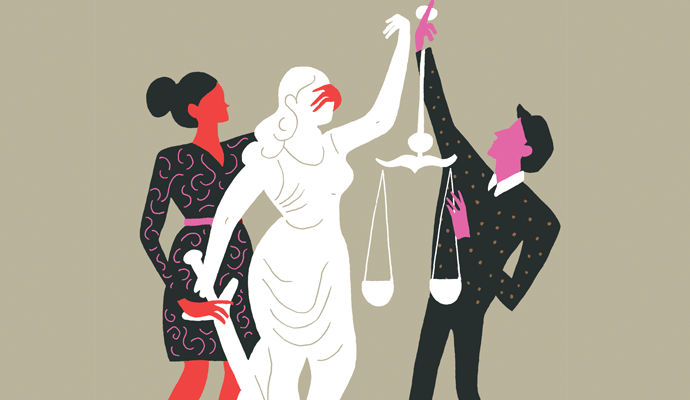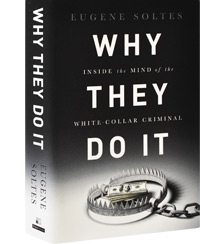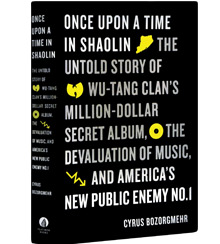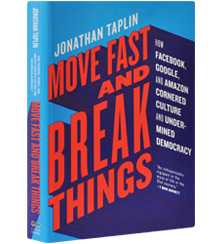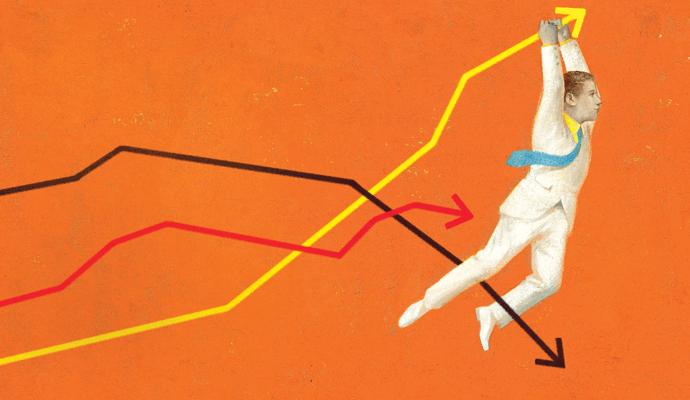Best Business Books 2017: Narratives
Crimes, Not Misdemeanors
Eugene Soltes
Why They Do It: Inside the Mind of the White-Collar Criminal (Public Affairs, 2016)
Cyrus Bozorgmehr
Once Upon a Time in Shaolin: The Untold Story of Wu-Tang Clan’s Million-Dollar Secret Album, the Devaluation of Music, and America’s New Public Enemy No. 1 (Macmillan, 2017)
*A TOP SHELF PICK
Jonathan Taplin
Move Fast and Break Things (Little, Brown, 2017)
White-collar crime. We may think it’s always been with us. But it was a novel concept in 1939, when sociologist Edwin Sutherland coined the phrase, according to a new book by Harvard Business School (HBS) professor Eugene Soltes, Why They Do It: Inside the Mind of the White-Collar Criminal. Sutherland was the first to argue that stealing wasn’t restricted to deviant, lower-class individuals on the streets “but rather was present within many of the leading corporations of America,” writes Soltes.
Others believe the crime is what is sanctioned by law and hence goes unpunished. “I say corruption, but it’s all legal, because that’s how institutional corruption works — the guys taking the money make the laws,” writes Cyrus Bozorgmehr in Once Upon a Time in Shaolin: The Untold Story of Wu-Tang Clan’s Million-Dollar Secret Album, the Devaluation of Music, and America’s New Public Enemy No. 1.
Two of this year’s three narrative-focused best business books raise important and uncomfortable questions about the way in which we define and attempt to curtail and punish corporate practices that aren’t good for society (or how we fail to make those attempts). The third, Jonathan Taplin’s Move Fast and Break Things, considers the way in which some of the largest digital companies seek to capture our attention.
Not many case studies on white-collar crime are taught at HBS, where Soltes teaches accounting and management. But struck by the “bewildering number of theories about why white-collar criminals ‘did it,’” he began talking to them directly, ultimately corresponding with and visiting more than four dozen of the most senior executives who oversaw some of the most significant corporate failures in history.
Soltes questions common theories, like one most recently espoused by former federal prosecutor Preet Bharara, who said the white-collar criminals he prosecuted were “‘highly skilled at cost-benefit analysis’ and they ‘weigh the risk of getting caught against the potential reward, and they decide it’s worth the risk.’” Rather, there seemed to be no method to the madness of the executives the author interviewed. Sam Waksal, the former ImClone CEO who went to jail for insider trading (and who also tipped Martha Stewart), tells Soltes, “They wrote about me as if there was some giant byzantine idea that I was trying to perpetrate…[but] I don’t know what I was thinking.… I wasn’t, sadly.’” Ponzi schemer extraordinaire Bernie Madoff tells Soltes, “I really have not been able to figure out how I let myself do this. Is there a flaw in me?”
In Soltes’s argument, the whys have more to do with the facelessness of modern big business — you never have to meet the people you’re stealing from — and our minds’ reflexive power to convince ourselves that we’re not doing anything wrong. Many fall prey to what Plato called the “noble lie,” the idea that whatever bad actions you undertake are fine if they further some grand and good goal, such as keeping shareholders satisfied. “I never meant to hurt anybody,” one former CEO told Soltes. “My motivation was for the company to do well.”
Soltes, who is clearly sympathetic toward some of those he portrays, explores difficult questions about what constitutes a crime. What’s the difference between a CEO participating in illicit insider trading and a hedge fund manager trading on better information than others have? What about the difference between earnings management as practiced by much-lauded former GE CEO Jack Welch and criminal manipulation of earnings? Between misleading disclosures of the sort that regularly are employed to sell used cars and those that send CEOs to jail for securities fraud? Or between innovative rewriting of regulations à la Uber and criminal rule breaking? And how should an executive navigate those distinctions, such as they are, in a world of information overload and split-second decision making?
I found the book totally compelling and insightful — until I got to Enron. Soltes, who describes Enron’s collapse as the result of a culture that saw “every problem as something that could be solved with greater financial ingenuity,” tells the story through the lens of Andrew Fastow, the company’s former CFO. Fastow, we learn, used aggressive yet legal accounting techniques to create a more pleasing, but ultimately misleading, picture of financial reality. “Although each step appears guiltless on its own, when all of the steps are put together the outcome may appear far more mischievous,” Soltes writes.
Which, no.
Certainly, too-clever financial engineering was a big part of the Enron story, but Fastow was actually charged with much more egregious criminal acts, such as making secret side agreements that explicitly violated accounting laws, as well as with looting some of the financial structures he set up; Soltes ignores both of these facts. Did the HBS professor himself fall victim to the disease of rationalization that affects the CEOs he describes? Because Soltes wanted to tell a story — and an important one, at that — about blurry lines, he ignored the inconvenient facts that didn’t fit his picture. Still, it’s indisputably true that Fastow’s shenanigans, both legal and illegal, helped destroy Enron, costing billions of dollars and thousands of jobs.
A Mysterious Album
A white-collar criminal features prominently in Cyrus Bozorgmehr’s Once Upon a Time in Shaolin, my pick for the year’s best business book on narratives. This is the rollicking narrative of the rap group Wu-Tang Clan’s notorious efforts to create an album that, rather than being mass marketed, would be valued like a work of art — sold to only one buyer, who would be the only one who could ever play it. “There was no template for selling a single copy of an album, no identifiable set of collectors or buyers, no clear medium for the sale, no legal structure whatsoever,” writes Bozorgmehr (who was an advisor to the project and works for a mysterious Mr. S. who funded it, and who himself remains something of a cipher).
Did the author himself fall victim to the disease of rationalization that affects the CEOs he describes?
But the book also invokes much deeper themes. It’s about the group’s efforts to rectify the fact that file-sharing and streaming business models have rendered it nearly impossible for most musicians to make money from their work. “Tragically, in a weird evolutionary flaw, the less effort people have to make for something, the less they value it,” Bozorgmehr writes.
The author also has his own answers to some of the questions Soltes raises. About corporations, he writes that “their very facelessness abrogates the need for morality.” Executives who are good people “allow themselves to collude in shocking practices because they have bought into the insidious architecture of amorality. It’s numbers, it’s statistics, it’s my job, it’s not my personal morality.” And oh, those noble lies. “A business is responsible to its shareholders rather than the public good in the same way that a lawyer is responsible to his client’s interests rather than the truth,” writes Bozorgmehr. “And that inevitably leads to a winner-take-all mentality without the nuisance of conscience.”
The twist in this story — and it’s a doozy — is that Wu-Tang’s album, which was designed to raise moral and philosophical questions about how we value music, ended up being sold to one of the most notorious and amoral figures of our time: Martin Shkreli. The so-called Pharma Bro, who gleefully hiked the price of a lifesaving drug, was found guilty last summer of securities fraud for an unrelated scheme. The members of Wu-Tang had no clue about Shkreli’s activities when the then-unknown young entrepreneur bought their album in the summer of 2015. So when Shkreli burst into the headlines that fall, it was a crisis. “This wasn’t just calamitous,” writes Bozorgmehr. “This was Calamity walking into a bar, sweet-talking Catastrophe, getting really drunk together, smoking some crack, punching Fiasco in the face, then going on a shooting spree while eating orphans and setting fire to kittens.”
Bozorgmehr ultimately decides that because what Wu-Tang wanted to do was foster a debate, it’s actually good that the album ended up in Shkreli’s hands. “Maybe this was the ultimate artistic statement,” Bozorgmehr writes. “If we don’t support musicians as a society and all contribute to [music’s] sustainability, then it will end up in the hands of the most ruthless capitalists out there.”
Bozorgmehr’s somewhat sympathetic view of Shkreli is surprising. It is at best ironic that what Shkreli did by price-gouging the seriously ill was morally reprehensible but legally fine, whereas he was convicted criminally for running a Ponzi-like scheme in which everyone got paid back. And maybe Shkreli himself was posing a question about how our system works. “Much of what Martin was actually doing was entrenched in the worldview of thousands of cutthroat companies,” Bozorgmehr writes.
Fast and Furious
The challenge of sustaining viable business models for content is at the center of Jonathan Taplin’s Move Fast and Break Things. “The streets of American cities are haunted by the ghosts of bookstores and record stores, which have been destroyed by the greatest thugs in the history of the culture industry,” the cultural critic Leon Wieseltier noted in 2015.
In Taplin’s view, the technological revolution that has swept our world has betrayed all the original idealistic expectations about aiding art and making the world a better place — and has done even worse. Founding fathers Thomas Jefferson and James Madison feared the power of monopolies enough to insist that “freedom from monopoly” should be in the Bill of Rights. But the all-important digital universe we now live in is ruled by a series of extremely powerful companies that have a massive influence on the distribution of content, including Facebook, Apple, and Amazon.
The attitudes of Silicon Valley elites who have built these companies, Taplin contends, often follow the famous Mark Zuckerberg advice with which he begins his book: “Move fast and break things. Unless you are breaking stuff, you aren’t moving fast enough.” In the case of the Internet giants, “breaking things,” including rules and regulations, lands their CEOs on magazine covers and ultrarich lists, not in jail. For instance, Tap-lin details how YouTube’s founders flouted copyright law, with one even emailing another about how to get content: “Steal it!”
Taplin argues that Silicon Valley’s belief in the nobility of its goals enables its companies to pursue them without a sense that they are doing anything wrong. Critical to the success of Silicon Valley giants, he writes, “is the ability to maintain the illusion that they are working for the greater good even while pursuing policies that serve only their own needs.”
On the contrary, Taplin says, real damage is being done. The fact that a few very large companies garner the overwhelming majority of Internet advertising has made it challenging for content creators, producers, and publishers to make a living. And the relentless rise of these companies may harm humanity. Taplin quotes author and educator Neil Postman, who brilliantly contrasted the dystopian visions presented by George Orwell’s 1984 and Aldous Huxley’s Brave New World. “Orwell feared those who would deprive us of information. Huxley feared those who would give us so much that we would be reduced to passivity and egoism,” Postman wrote. “Orwell feared that the truth would be concealed from us. Huxley feared that the truth would be drowned in a sea of irrelevance.”
Taplin does engage in some obvious oversimplification, such as when he asserts that the “libertarians who control the major Internet firms do not really believe in democracy,” and pins much of the blame on — who else? — the Koch brothers. But certainly, he’s right that the old model that enabled content creators to make a living has been smashed to bits.
In the end, the three books leave us wondering. Why do good people do bad things? Why do some of those people get rewarded, while some go to jail? How can we value content in a digital world where content seemingly has no value? Bozorgmehr writes, “The best questions have no right answer, no linear sequence of logic or moral clarity, but dance forever in shifting shades of gray.”
Reprint No. 17411
Author profile:
- Bethany McLean is a contributing editor at Vanity Fair. Her most recent book is Shaky Ground: The Strange Saga of the U.S. Mortgage Giants (Columbia Global Reports, 2015).


